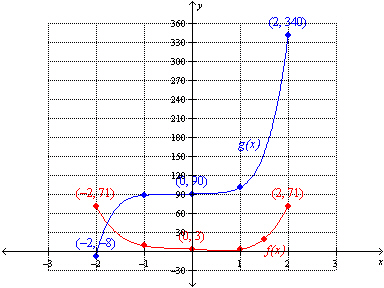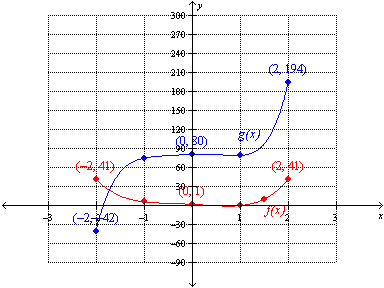A) ![]()
B) ![]()
C) ![]()
D) ![]()
E) ![]()
Correct Answer

verified
Correct Answer
verified
Multiple Choice
If  and
and  , find
, find  .
.
A) ![]()
B) ![]()
C) ![]()
D) ![]()
E) ![]()
Correct Answer

verified
Correct Answer
verified
Multiple Choice
If  and
and  , find
, find  .
.
A) ![]()
B) ![]()
C) ![]()
D) ![]()
E) ![]()
Correct Answer

verified
Correct Answer
verified
Multiple Choice
Which one of the following is the graph of  ?
?
A) ![]()
B) ![]()
C) None of these options
D) ![]()
E) ![]()
Correct Answer

verified
B
Correct Answer
verified
Multiple Choice
Determine the end behavior of the function  .
.
A) As ![]() and
and ![]() .
.
B) As ![]() and
and ![]() .
.
C) As ![]() and
and ![]() .
.
D) As ![]() and
and ![]() .
.
E) As ![]() and
and ![]() .
.
Correct Answer

verified
Correct Answer
verified
Multiple Choice
Suppose that  is directly proportional to the 4th power of
is directly proportional to the 4th power of  . If it is known that
. If it is known that  when
when  , find the proportionality constant. Round to the nearest hundredth.
, find the proportionality constant. Round to the nearest hundredth.
A) ![]()
B) ![]()
C) ![]()
D) ![]()
E) ![]()
Correct Answer

verified
Correct Answer
verified
Multiple Choice
Use the table below to find . 
A) -39
B) ![]()
C) ![]()
D) -380
E) ![]()
Correct Answer

verified
Correct Answer
verified
Multiple Choice
Suppose that  is directly proportional to the 5th power of
is directly proportional to the 5th power of  . Which one of the following equations expresses this proportionality? .
. Which one of the following equations expresses this proportionality? .
A) ![]()
B) ![]()
C) ![]()
D) ![]()
E) ![]()
Correct Answer

verified
E
Correct Answer
verified
Multiple Choice
Which one of the following graphs represents the function  ?
?
A) ![]()
B) ![]()
C) None of these options
D) ![]()
E) ![]()
Correct Answer

verified
B
Correct Answer
verified
Multiple Choice
If  and
and  , find
, find  .
.
A) ![]()
B) ![]()
C) ![]()
D) ![]()
E) ![]()
Correct Answer

verified
Correct Answer
verified
Multiple Choice
Use the table below to find . 
A) -27
B) -1
C) -36
D) -12
E) 12
Correct Answer

verified
Correct Answer
verified
Multiple Choice
Use the graph below to find an approximation of  .
. 
A) -8
B) 63
C) -2
D) 71
E) 79
Correct Answer

verified
Correct Answer
verified
Multiple Choice
Which one of the following functions best models the data given in the table below. 
A) Exponential
B) Power
C) Quadratic
D) Linear
E) None of these options
Correct Answer

verified
Correct Answer
verified
Multiple Choice
The mouse population in a small desert area is modeled by the function  where
where  is measured in days. When is the maximum population attained and what is the maximum population?
is measured in days. When is the maximum population attained and what is the maximum population?
A) After 175 days, the mouse population is 0.
B) After 9 days, the mouse population is 1,310.
C) After 84 days, the mouse population is 1,310.
D) After 84 days, the mouse population is 7,005.
E) After 9 days, the mouse population is 2,485.
Correct Answer

verified
Correct Answer
verified
Multiple Choice
Use the graph below to find  .
. 
A) -42
B) 83
C) -2
D) 41
E) -1
Correct Answer

verified
Correct Answer
verified
Multiple Choice
The loudness  of a sound (measured in decibels dB) is inversely proportional to the square of the distance
of a sound (measured in decibels dB) is inversely proportional to the square of the distance  from the source of the sound. Suppose a person who is 4 ft from a hair dryer experiences a sound level of 60 dB. How loud is the hair dryer for a person 7 ft away? Round to the nearest tenth.
from the source of the sound. Suppose a person who is 4 ft from a hair dryer experiences a sound level of 60 dB. How loud is the hair dryer for a person 7 ft away? Round to the nearest tenth.
A) 0.1 dB
B) 19.6 dB
C) 1.2 dB
D) 70.0 dB
E) 960.0 dB
Correct Answer

verified
Correct Answer
verified
Multiple Choice
Find the equation(s) of the vertical asymptote(s) of  .
.
A) ![]()
![]()
B) ![]()
![]() and
and ![]()
![]()
C) ![]()
![]()
D) ![]()
![]() and
and ![]()
![]()
E) ![]()
![]() and
and ![]()
![]()
Correct Answer

verified
Correct Answer
verified
Multiple Choice
Determine the end behavior of  .
.
A) As ![]() and as
and as ![]() .
.
B) As ![]()
![]() and as
and as ![]()
![]() .
.
C) As ![]() and as
and as ![]()
![]() .
.
D) As ![]() and as
and as ![]() .
.
E) As ![]()
![]() and as
and as ![]() .
.
Correct Answer

verified
Correct Answer
verified
Multiple Choice
Suppose that  is inversely proportional to the cube root of
is inversely proportional to the cube root of  . Which one of the following is an equation that expresses this statement?
. Which one of the following is an equation that expresses this statement?
A) ![]()
B) ![]()
C) ![]()
D) ![]()
E) ![]()
Correct Answer

verified
Correct Answer
verified
Multiple Choice
Determine the behavior of the function  as
as  .
.
A) As ![]() ,
, ![]() .
.
B) As ![]() ,
, ![]() .
.
C) As ![]() ,
, ![]() .
.
D) As ![]() ,
, ![]() .
.
E) As ![]() ,
, ![]() .
.
Correct Answer

verified
Correct Answer
verified
Showing 1 - 20 of 71
Related Exams